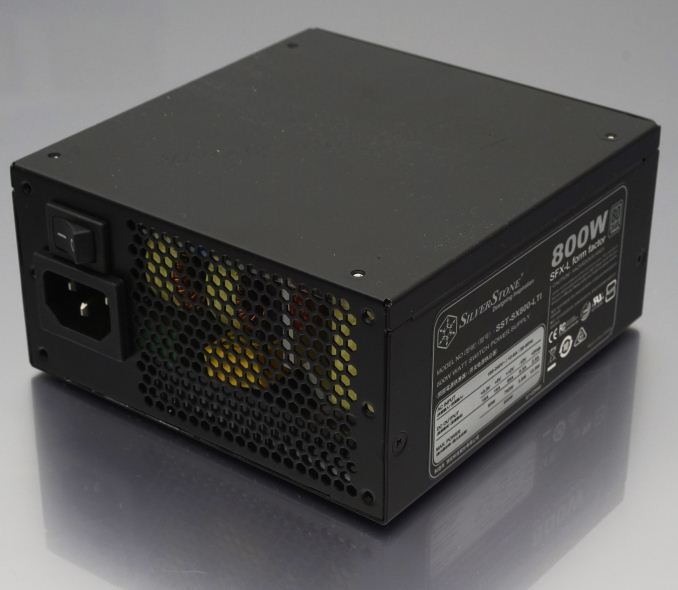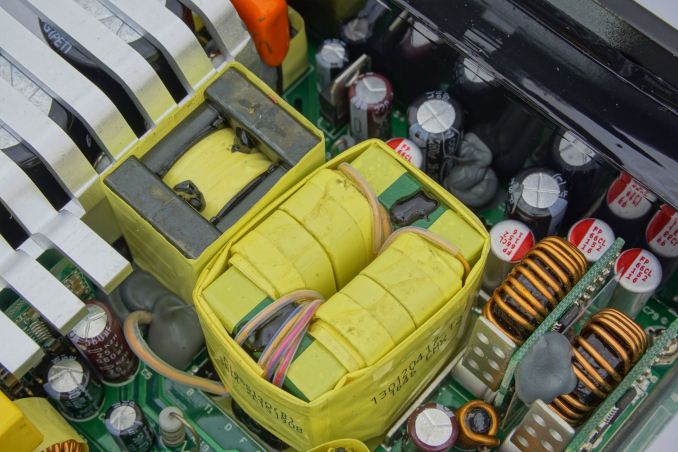The SilverStone SX800-LTI SFX-L 800W PSU Review: Big PSU, Small Niche
by E. Fylladitakis on January 18, 2018 9:00 AM EST- Posted in
- Cases/Cooling/PSUs
- SilverStone
- SFX
- SFX-L
Conclusion
ATX PSUs were the focus of R&D for decades while, at the same time, SFX designs were hardly available at all. This led to a massive performance gap between ATX and SFX units, as the latter started appealing to home users and gamers just a few years ago. Only a couple of years ago, the power quality of SFX units still was rather poor. The SilverStone SX700-LPT and, later on, the Enermax Revolution SFX 650W were the first SFX units that gave us performance figures on par with high-performance ATX units.
SilverStone is a company strongly focused on the R&D of small form factor cases (SFF), systems, and other related parts. They have several compact cases and products designed for high-end living room systems, including designs that were designed with gamers in mind. Therefore, their efforts to market the very best SFX PSUs available are not unfounded.
The SX800-LTI not only brings a record-high power output for an SFX-L design, but also is even further improved, with exceptional energy conversion efficiency and better power output quality than its predecessors. Note that the power quality is still not on par with that of top-tier ATX PSUs and it definitely is much louder than any equally powerful ATX design, but it would unquestionably be unfair to compare the SX800-LTI to any ATX unit. As far as SFX/SFX-L designs go, the SX800-LTI has the best overall performance that we have encountered to this date.
The extra length of the SX800-LTI makes it incompatible with most SFX-compliant cases. According to their compatibility charts, even most of SilverStone’s own cases are incompatible with this PSU. Its short wires make it incompatible with ATX-compliant cases as well, plus there really is no reason to purchase such an expensive SFX-L unit if one is planning to use an ATX-compliant case, as ATX PSUs are significantly less expensive and there is a much wider selection available. That the SX800-LTI is fully modular and there are adapters/cable sets available to allow its installation in an ATX case is a boon, but only for those that, for any given reason, may have to switch from their SFX-based system to an ATX-based system in the future.
The only real problem with this unit is that it lacks purpose. The SX800-LTI has only one CPU/EPS 8-pin connector, meaning that it cannot be used to power top-tier motherboards that have two 8-pin connectors, which is reasonable considering that current designs of such motherboards are all but impossible to fit inside SFX-compliant cases anyway. That leaves only the GPU(s) as the major load of the system. The power output and class of the SX800-LTI suggest that it needs at least two GPUs to even reach efficient loading levels. The only configuration that could bring the PSU’s loading up to 50-55% is that of SilverStone’s only compatible case, the RVZ02/ML08, with an NVIDIA TITAN V or AMD VEGA 64 installed. When moving to Micro-ATX motherboards with two PCIe ×16 slots, such as the Asus ROG Strix Z270G, cases that are roomy enough to house two full-size graphics cards also support ATX PSUs, so the SX800-LTI is an unappealing option. Only a SFX-compliant case designed for high-end Micro ATX motherboards is the natural habitat of the SX800-LTI, and there just are not many (if any) available at this time.












25 Comments
View All Comments
Meaker10 - Friday, January 19, 2018 - link
It can help room temperatures and with a small forn factor case it could make a difference to internal temperatures.sonny73n - Friday, January 19, 2018 - link
@meaker10Huh? PSU & temperatures? What?!
DanNeely - Friday, January 19, 2018 - link
All the power lost due to PSU inefficiency is extra heat added to the room. When it's cold it works like supplemental furnace/etc (if electric heat is cost effective depends on what the other heat source is); in the summer it's just more heat for the AC to push out of the building.meacupla - Saturday, January 20, 2018 - link
But if a 600W PSU is pulling 90% efficiency at 400W, where as this 800W PSU is pulling 94% efficiency at 400W, the 600W would be consuming 444W, versus the 800W would be consuming 425W.A 19W difference is hardly going to result in a noticeable difference inside the case, since PSUs only expel heat.
Macpoedel - Tuesday, January 23, 2018 - link
According to Silverstone's charts the 500W SFX-L PSU is 91% efficient at a 400W load (with a 230V AC input voltage), this 800W PSU is 95 % efficient at the same load. That comes down to 439W and 421W from the wall, let's take 20W for simplicity.If the PC were to have a continuous load of 400W all year long, that makes 175.2 kWh. In my country electricity is pretty expensive, around 0.21€/kWh (probably a bit more now, 0.21 was a few years ago).
175.2 kWh would then cost €36.7, but the price difference between the 500W and 800W variant is around €100, so you'd need about 3 years of continous load at 50% to benefit from the better efficiency.
Let's also assume this PSU isn't powering a mining rig but a workstation, that gets used around 8 hours a day, that makes 9 years before the higher efficiency pays off. I doubt many PSU's are used for longer than that.
Also, in most cases a 400W continuous load is a very unrealistic assumption, most pc's idle most of the time, even workstations (and this is not a server PSU). Below 20% load, both PSU's have pretty much the same efficiency.
So when exactly does the higher efficiency pay off for pc's that don't have a continuous load? Pretty much never...
Much more important are the warranty and component quality, and it's not like the 800W PSU is so much better in those regards, it's not going to last longer, the chances of failure are the same.
I'd even argue in favor of a 80Plus Bronze PSU instead of 80Plus Gold, because those gains in efficiency are very slim as well, but then component quality often is a bit worse and the warranty period goes down to 3 years or lower, so paying more for better quality makes sense there (for the same capacity!)
Now if you want your workstation to consume as little power as possible, be my guest and pay double the price for a PSU that only has to deliver half of its capacity at most, just don't expect the investment to pay off.
Macpoedel - Tuesday, January 23, 2018 - link
Oh when I say 175.2 kWh, I'm talking about that 20W power difference between 91 and 94% efficiency, not total consumption, that would cost a lot more than €36 of course.Foeketijn - Friday, January 19, 2018 - link
I think it would be more likely be, because it is far more easy to get the titanium certification on a high powered psu. There is a reason why there are no affordable high efficiency low powerd psu's.The Benjamins - Thursday, January 18, 2018 - link
It only having 1 4+4 EPS sucks, you can't use this for the AsRock X399M board in a CaseLabs Bullet BH4.PeachNCream - Thursday, January 18, 2018 - link
The article's title is like a perfect TL;DR summary. As far as SFX goes, it's a small niche product. I can't think of too many system builds that would require that much power output inside a small enough case, that also supports the larger-than-SFX physical dimensions.Lau_Tech - Thursday, January 18, 2018 - link
These "stuff i found in my attic" reviews are really blockbuster stuff, eh?